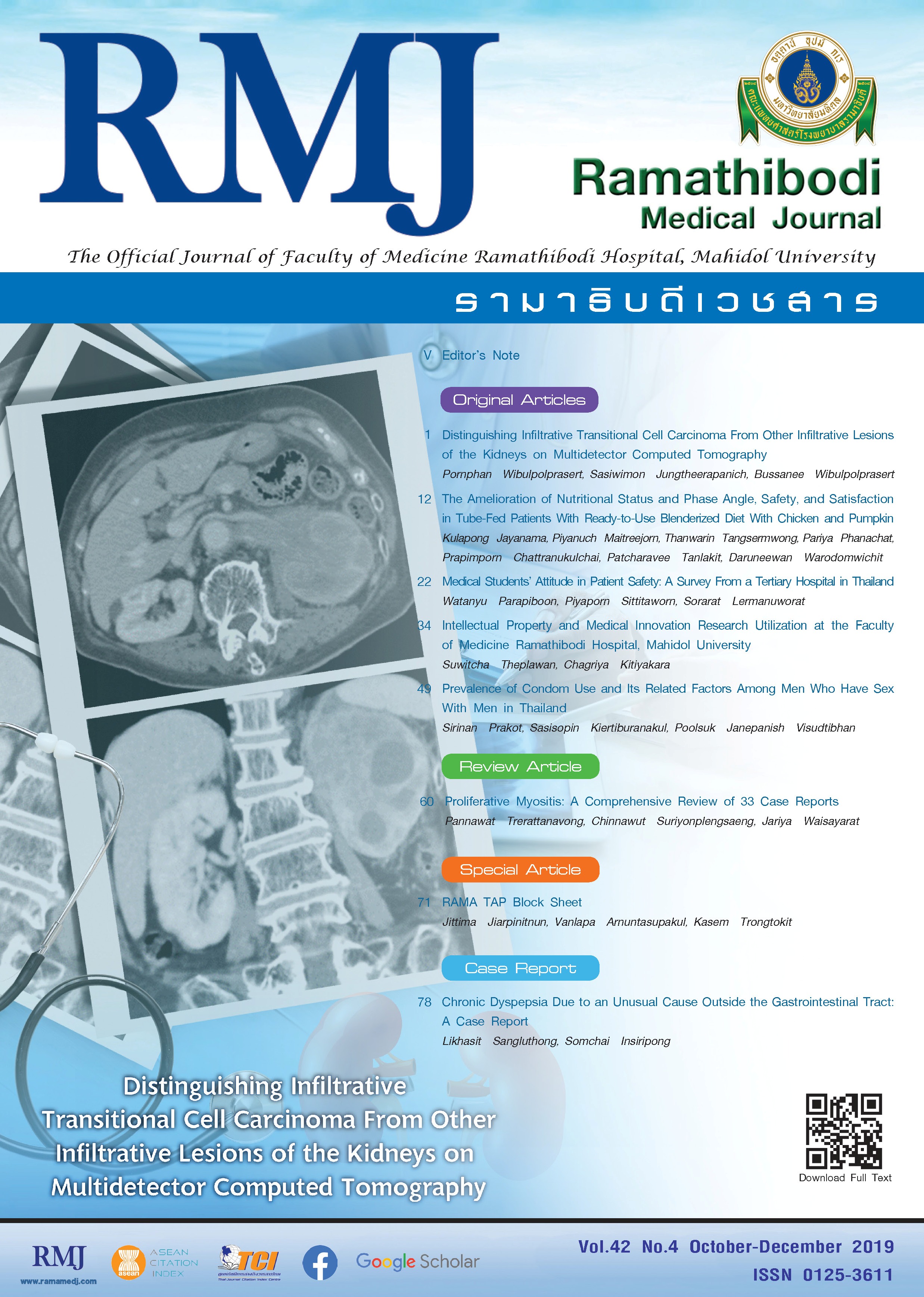Medical Students’ Attitude in Patient Safety: A Survey From a Tertiary Hospital in Thailand
Main Article Content
Abstract
Background: Understand patient safety attitude in medical students is important and useful to improve teaching on patient safety at undergraduate level.
Objective: To assess the attitude on patient safety in clinical year medical students.
Methods: A cross-sectional survey was conducted in 4th to 6th year medical students in Maharat Nakhon Ratchasima Hospital from August to September 2018. The 26-item Attitudes toward Patient Safety Questionnaire (APSQ) was sent via Google Forms to medical students for voluntary, anonymous answer. The 9 topics of patient safety culture were collected and analyzed.
Results: There were 106 of 128 medical students responded to the questionnaire. In 9 topics of safety culture, the highest positive attitude in medical students was working hours as an error cause (76.1%). Meanwhile, the lowest positive attitude was professional incompetence as an error cause (26.9%). Neither academic year nor grade point average (GPA) of medical students was associated with positive attitude score. Half of medical students reported a positive attitude of the importance of patient safety in the curriculum.
Conclusions: Medical students had positive attitude of patient safety. Perspective in systems thinking of patient safety should be emphasized in patient safety education of medical students.
Article Details
References
Grober ED, Bohnen JM. Defining medical error. Can J Surg. 2005;48(1):39-44.
Abd Elwahab S, Doherty E. What about doctors? The impact of medical errors. Surgeon. 2014;(6):297-300. doi:10.1016/j.surge.2014.06.004.
Weaver SJ, Lubomksi LH, Wilson RF, Pfoh ER, Martinez KA, Dy SM. Promoting a culture of safety as a patient safety strategy: a systematic review. Ann Intern Med. 2013;158(5 Pt 2):369-374. doi:10.7326/0003-4819-158-5-201303051-00002.
Kachalia A. Improving patient safety through transparency. N Engl J Med. 2013;369(18):1677-1679. doi:10.1056/NEJMp1303960.
Kohn LT, Corrigan JM, Donaldson MS, eds. To Err Is Human: Building a Safer Health System. Committee on Quality of Health Care in America, Institute of Medicine. Washington, DC: National Academy Press; 2000. https://books.nap.edu/catalog/9728.html. Accessed April 4, 2019.
Oates K, Wilson I, Hu W, Walker B, Nagle A, Wiley J. Changing medical student attitudes to patient safety: a multicentre study. BMC Med Educ. 2018;18(1):205. doi:10.1186/s12909-018-1313-0.
Wetzel AP, Dow AW, Mazmanian PE. Patient safety attitudes and behaviors of graduating medical students. Eval Health Prof. 2012;35(2):221-238. doi:10.1177/0163278711414560.
Carruthers S, Lawton R, Sandars J, Howe A, Perry M. Attitudes to patient safety amongst medical students and tutors: developing a reliable and valid measure. Med Teach. 2009;31(8):e370-e376.
Google. Google Forms. https://www.google.com/forms. Accessed April 4, 2019.
Walton M, Woodward H, Van Staalduinen S, et al. The WHO patient safety curriculum guide for medical schools. Qual Saf Health Care. 2010;19(6):542-546. doi:10.1136/qshc.2009.036970.
Reason J. Human error: models and management. BMJ. 2000;320(7237):768-770. doi:10.1136/bmj.320.7237.768.
Wong KC. Using an Ishikawa diagram as a tool to assist memory and retrieval of relevant medical cases from the medical literature. J Med Case Rep. 2011;5:120. doi:10.1186/1752-1947-5-120.
Braithwaite J, Herkes J, Ludlow K, Lamprell G, Testa L. Association between organisational and workplace cultures, and patient outcomes: systematic review protocol. BMJ Open. 2016;6(12):e013758. doi:10.1136/bmjopen-2016-013758.
Liu H, Li Y, Zhao S, et al. Perceptions of patient safety culture among medical students: a cross-sectional investigation in Heilongjiang Province, China. BMJ Open. 2018;8(7):e020200. doi:10.1136/bmjopen-2017-020200.
Leung GK, Ang SB, Lau TC, Neo HJ, Patil NG, Ti LK. Patient safety culture among medical students in Singapore and Hong Kong. Singapore Med J. 2013;54(9):501-505. doi:10.11622/smedj.2013172.




